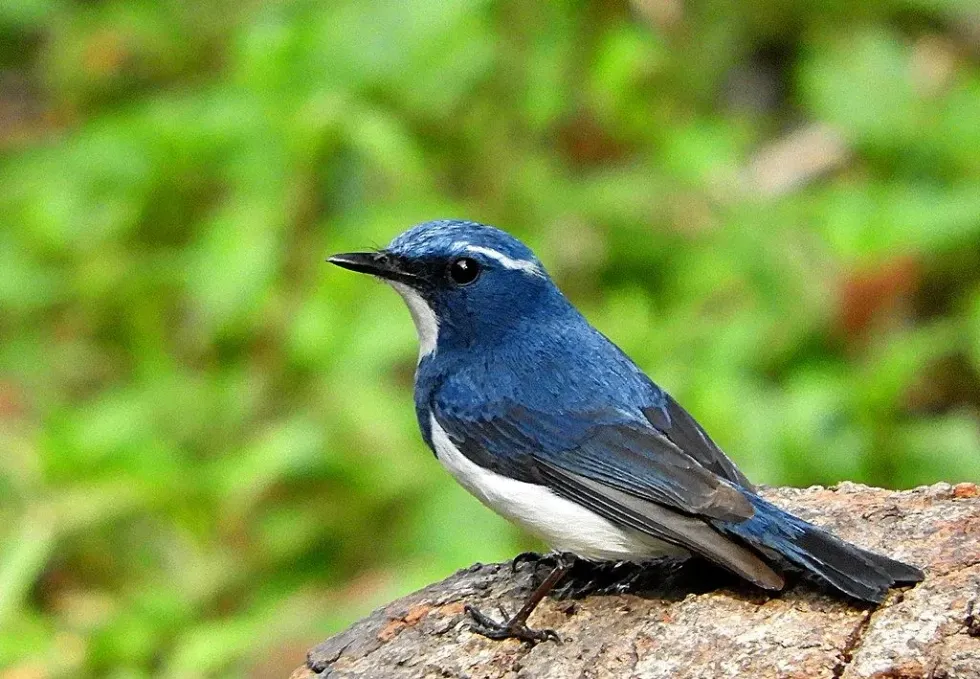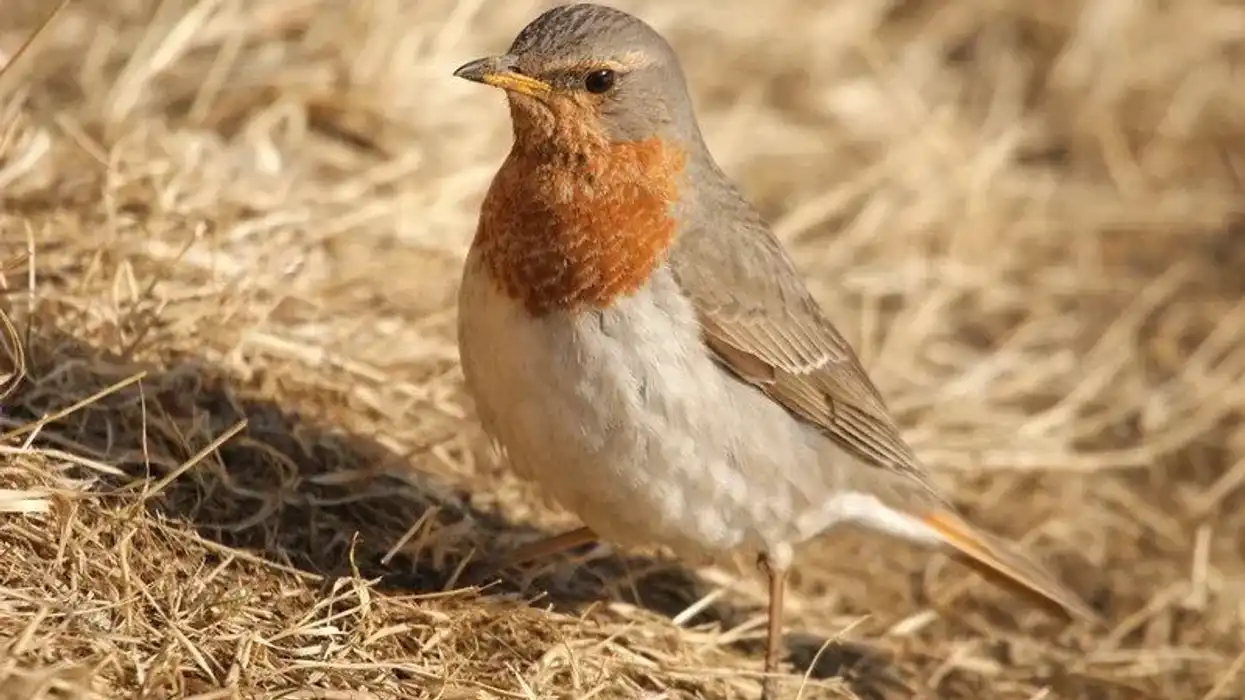One of the most beautiful members of the Ficedula family is the Ficedula superciliaris. The ultramarine flycatcher is an absolute sight to behold, chirping melodiously from west to east along the beautiful Himalayas and other countries of the Indian subcontinent.
Also called the white-browed blue flycatcher, this little bird breeds in the foothills of the Himalayas and winters in the warmer regions of southern India. If you are eager to know about its preferred habitat, open mixed forests is your answer.
Breeding takes place mainly in the hot summer months when this Old World bird becomes a frequent visitor to the western Himalayas. The ultramarine flycatcher female lays about three to five eggs in each breeding season. The white color on the supercilium and tail show clinal variation along the foothills of the Himalayas.
For more relatable content, check out these vermilion flycatcher facts and least flycatcher facts for kids.
Ultramarine Flycatcher Interesting Facts
What type of animal is an ultramarine flycatcher?
The ultramarine flycatcher (Ficedula superciliaris) is a type of flycatcher.
What class of animal does an ultramarine flycatcher belong to?
This white-browed blue flycatcher belongs to class Aves.
How many ultramarine flycatchers are there in the world?
We do not have the total count on the number of ultramarine flycatchers in the world.
Where does an ultramarine flycatcher live?
This little bird switches places as the seasons change. In the hot summer days, the ultramarine flycatcher breeds in the foothills of the beautiful Himalayas. When the cold months begin, they move southwards and spend the winters in southern India.
The summer range of the western race of this bird extends all the way from the foothills of the Himalayas, Jammu and Kashmir, Himachal Pradesh to Uttarakhand. The eastern race's range continues in the eastern Himalayas, the northeastern states of India, and parts of Nepal and Bhutan.
There are speculations of a third race which is found in the lower hills of Nagaland and Meghalaya, northeastern states of India, and in the Khasi and Cachar hills too.
The winter months witness these flycatchers moving southwards to central India, covering the states extending from Delhi to Maharashtra and Goa. They also move eastwards towards Orissa and Andhra Pradesh. Few populations have also been spotted in the Indian state of Sikkim, Bangladesh, and Nepal.
What is an ultramarine flycatcher's habitat?
Open mixed forests of pine, fir, oak, and rhododendron trees is their preferred habitat. Occasionally, orchards have also been preferred as an ideal habitat.
Who do ultramarine flycatchers live with?
All flycatchers are known to survive alone.
How long does an ultramarine flycatcher live?
We are not aware of the lifespan of this species. However, other flycatcher species have an average lifespan of three to seven years.
How do they reproduce?
These birds are known to breed between altitudes of 5905-10,498 ft (1800-3200 m), usually concentrated within 6561-8858 ft (2000-2700 m). The breeding season of the ultramarine flycatcher begins mid-April and goes on until the early weeks of July.
These birds make small, comfortable nests. The nests are built using small bark strips, twig, fine moss, and grass.
The nest is then lined neatly with rootlets and hair. To ensure complete safety from predators, these nests are placed in clefts or holes of large trees. At least 23 ft (7 m) in height from the ground is maintained while building the nests.
About three to five eggs are laid by the ultramarine flycatcher female bird. These eggs are usually of a dull olive tone, but sometimes may even be slightly brownish. The egg is entirely adorned with tiny red-brown speckles. Sometimes the speckles are concentrated only towards the larger end which gives the appearance of a cap.
What is their conservation status?
The conservation status of the ultramarine flycatcher (Ficedula superciliaris) is Least Concern.
Ultramarine Flycatcher Fun Facts
What do ultramarine flycatchers look like?
This bird is actually not very big and it is usually smaller than a sparrow. The body has a well stocky build.
The male ultramarine flycatcher has a beautiful marine blue hue above. The neck and the sides of the head are all blue. There is a distinct patch of white tint running from the throat, down through the breast all the way to the belly.
The name white-browed blue flycatcher is given to this bird due to the presence of a white streak on the tail and brow. However, this presence on the supercilium and tail show clinal variation on birds from the western to the eastern side along the Himalayan foothills. This feature helps to distinguish the three subspecies under this bird.
The western subspecies, which is a common visitor to the western Himalayas, has a clear white hue on the supercilium, as well as an off-white base to the feathers of the outer tail. The eastern subspecies found mainly in the eastern Himalayas do not have distinct white patches present.
The possibly third subspecies of south Assam completely lacks the presence of any supercilium.

How cute are they?
The ultramarine flycatcher (Ficedula superciliaris) is absolutely adorable.
How do they communicate?
The ultramarine flycatcher call consists of beautiful 'trrr' chirps which are absolutely pleasant to hear.
How big is an ultramarine flycatcher?
The ultramarine flycatcher (Ficedula superciliaris) grows up to 4.3-4.95 in (11-12.5 cm). This bird is almost twice the size of the bee hummingbird.
How fast can an ultramarine flycatcher fly?
We do not know the speed at which the ultramarine flycatcher (Ficedula superciliaris) can fly.
How much does an ultramarine flycatcher weigh?
The average weight of the ultramarine flycatcher (Ficedula superciliaris) is about 0.35 oz (10 g).
What are the male and female names of the species?
There are no specific names for the female and male birds of this species.
What would you call a baby ultramarine flycatcher?
In general, baby birds are called chicks or nestlings.
What do they eat?
The name is a clear giveaway, isn’t it? The ultramarine flycatcher munches down on insects mainly. It rarely feeds on fruits and berries. Other things these birds eat include termites, ants, flies, grasshoppers, crickets, spiders, earwigs, and worms. Occasionally, orchards provide them abundant food to feed upon.
Are they dangerous?
No, the white-browed blue flycatcher is not dangerous at all.
Would they make a good pet?
We do love the idea of keeping this beautiful bird as a pet, however they are wild birds and should be allowed to fly freely in their natural habitat.
Did you know...
Over 1000 species of birds live in both the western Himalayas and the eastern Himalayas.
Siberian cranes, greater flamingoes, and ospreys are some other birds who spend their winters in southern India.
What is the difference between ultramarine flycatcher vs rufous-gorgeted flycatcher?
The range of these two birds differ. The white-browed blue flycatcher is mainly found in Indian states, Nepal, and parts of Bangladesh.
They are also found in the ranges extending from west to east along the mighty Himalayas. The rufous-gorgeted flycatcher is found in abundance in the Indian subcontinent and the Southeast Asian countries including Laos, Myanmar, Bangladesh, Thailand, Nepal, Bhutan, and Vietnam.
For winter migration, these two bird species migrate to different areas. For ultramarine flycatchers, movements of this population have been seen towards southern India. For rufous-gorgeted flycatchers, movements of this population have been observed moving towards Vietnam, northern Laos, and Thailand.
The ultramarine flycatcher has blue upper parts, with a white hue extending from the throat down to the belly. It has white color on its brow and outer tail feathers as well. The rufous-gorgeted flycatcher has blue and gray color on its body, with a distinct rusty red color on its throat.
How long does it take flycatcher eggs to hatch?
Usually, flycatcher eggs hatch within one to three days. However, eggs of some flycatcher species take up to 12 days to hatch.
Here at Kidadl, we have carefully created lots of interesting family-friendly animal facts for everyone to discover! Learn more about some other birds from our great crested flycatcher facts and scissor-tailed flycatcher facts pages.
You can even occupy yourself at home by coloring in one of our free printable ultramarine flycatcher coloring pages.









